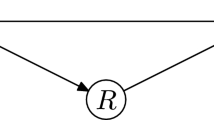Abstract
Cooperative Automatic Retransmission Request (C-ARQ) schemes exploit the broadcast nature of the radio channel by allowing those users which overhear a transmission to act as spontaneous relays when a packet has been received with errors at destination. Transmission takes place in two phases. First, the source transmits to the destination. In the case of error, retransmissions are then executed by the relays, providing the system with cooperative diversity. In this paper we analyze how the addition of these relays to the communication modifies the well-known hidden and exposed terminal problems associated to any medium access control protocol based on carrier sensing. This work is focused on Carrier Sensing Multiple Access (CSMA) protocols, such as the one defined in the IEEE 802.11 Standard. The theoretical study presented in this paper has been supported by computer-based simulations.






Similar content being viewed by others
References
Nosratinia A, Hunter TE, Hedayat A (2004) Cooperative communications in wireless networks. IEEE Commun Mag 42(10):74–80
Dianati M, Ling X, Naik K, Shen X (2006) A node-cooperative ARQ scheme for wireless ad hoc networks. IEEE Trans Veh Technol 46:1032–1044
Zimmermann E, Herhold P, Fettweis F (2005) On the performance of cooperative relaying protocols in wireless networks. Eur Trans Telecomm 16:5–16
Cerruti I, Fumagalli A, Gupta P (2008) Delay model of single-relay cooperative ARQ protocols in slotted radio network with poisson frame arrivals. IEEE/ACM Trans Netw 16:371–382
Alonso-Zárate J, Kartsakli E, Verikoukis Ch, Alonso L (2008) Persistent RCSMA: a MAC protocol for a distributed cooperative ARQ scheme in wireless networks. EURASIP J Adv Sig Proc 2008:1–13. doi:10.1155/2008/817401
Alonso-Zárate J, Verikoukis C, Alonso L (2009) Performance analysis of a persistent relay carrier sensing multiple access protocol. IEEE Trans on Wireless Comms 8(12):5827–5831
Zhu H, Cao G (2006) rDCF: a relay enabled medium access control protocol for wireless ad hoc networks. IEEE Trans Mob Comput 5:1201–1214
Korakis T, Tao Z, Slutskiy Y, Panwar S (2007) A cooperative MAC protocol for ad hoc wireless networks. In: Proc. of the fifth annual IEEE international conference on pervasive computing and communications workshops
Wireless LAN medium access control (MAC) and physical layer (PHY) specifications. IEEE Standard 802.11 (2007)
Bianchi G (2000) Performance analysis of the IEEE 802.11 distributed coordination function. IEEE J Sel Areas Commun 18:535–547
Kleinrock L, Tobagi FA (1975) Packet switching in radio channels: part II - the hidden terminal problem in carrier sense multiple-access and the busy-tone solution. IEEE Trans Commun 23:1417–1433
Vassis D, Kormentzas G (2008) Performance analysis of IEEE 802.11 ad hoc networks in the presence of exposed terminals. Elsevier Ad hoc Networks 6:474–482
Yeo J, Youssef M, Agrawala A (2004) Characterizing the IEEE 802.11 traffic: the wireless side. University of Meryland, College Park, Tech. Rep. CS-TR-457
Author information
Authors and Affiliations
Corresponding author
Additional information
This work has been supported by the research projects PASSENGER (PIEF-GA-2008-219561), CENTENO (TEC2008-06817-C02-02), and CO2GREEN (TEC2010-20823).
Rights and permissions
About this article
Cite this article
Alonso-Zarate, J., Alonso, L., Kormentzas, G. et al. Throughput Analysis of a Cooperative ARQ Scheme in the Presence of Hidden and Exposed Terminals. Mobile Netw Appl 17, 258–266 (2012). https://doi.org/10.1007/s11036-011-0338-y
Published:
Issue Date:
DOI: https://doi.org/10.1007/s11036-011-0338-y




